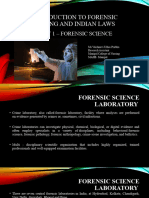0% found this document useful (0 votes)
107 views2 pagesI) Chemistry: This Division Deals With General Chemical Analysis. It Is Useful in Acid
Forensic science applies scientific methods to legal cases to help with criminal investigations. Forensic scientists visit crime scenes, analyze evidence carefully, and provide unbiased evidence in court. The main aims of forensic scientists are to establish links between crimes and suspects through techniques like analysis of biological samples, toxins, weapons, and digital evidence. Major forensic laboratories in India like DFSL and CFSL have multiple divisions utilizing technologies like DNA analysis, toxicology, ballistics, and psychology to examine different types of evidence and help solve crimes.
Uploaded by
Ashi AgarwalCopyright
© © All Rights Reserved
We take content rights seriously. If you suspect this is your content, claim it here.
Available Formats
Download as DOCX, PDF, TXT or read online on Scribd
0% found this document useful (0 votes)
107 views2 pagesI) Chemistry: This Division Deals With General Chemical Analysis. It Is Useful in Acid
Forensic science applies scientific methods to legal cases to help with criminal investigations. Forensic scientists visit crime scenes, analyze evidence carefully, and provide unbiased evidence in court. The main aims of forensic scientists are to establish links between crimes and suspects through techniques like analysis of biological samples, toxins, weapons, and digital evidence. Major forensic laboratories in India like DFSL and CFSL have multiple divisions utilizing technologies like DNA analysis, toxicology, ballistics, and psychology to examine different types of evidence and help solve crimes.
Uploaded by
Ashi AgarwalCopyright
© © All Rights Reserved
We take content rights seriously. If you suspect this is your content, claim it here.
Available Formats
Download as DOCX, PDF, TXT or read online on Scribd
/ 2























































































